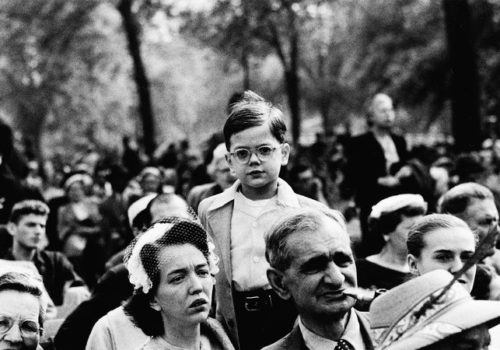It has been more than ten years now since The Metropolitan Museum of Art purchased all of Diane Arbus’ notes, prints and negatives, and the exhibition Diane Arbus: In the Beginning shows to the public, for the first time, a selection of her early photographs. In other exhibitions, early works are only displayed as a tool to root and illustrate the style which has yet to come, yet they are rarely analyzed on their own. At the MET Breuer, the curator Jeff Rosenheim’s approach is to see these photographs for what they actually are. The exhibition is unique because it focuses on the years preceding Diane Arbus’ public recognition, the photographs shown were taken between 1956 and 1962.
It is nearly impossible to evaluate the quality of these photographs since we know they are Diane Arbus’. One is forced to see them through the light of what is already known, but they still provide a sense of unprecedented freshness. Since 1962, her work has clearly been identified for what is now cliché and commonplace: the portrait of a wacky and eerie America. These pictures blur the lines and somehow succeed in giving the feeling of something original, and one is surprised by a blandness that is far from being unpleasant. The fascination for the odd is present in these photographs, but it is objectively marginal. The overall collection is closer to traditional street photography.
The exhibition ends with the presentation of A Box of Ten Photographs, a selection made by the artist herself in the early 1970s of her most famous images. By adding these celebrated pictures at the end of the show, completed by other photographers of her generation like Lee Friedlander and Gary Winogrand, the curator Jeff Rosenheim operates a coup de maître. He does not want the spectator to compare these two different sets of works but to focus on an important detail of her artistic process – the shift from 35mm to 6*6cm square format. By changing her camera, Diane Arbus not only changed the size of her negatives and prints, but also had to modify her attitude towards her subjects and became, somehow, more aware of her own specific approach. Thus, the portraits became less spontaneous with frontal and assumed poses. That is the argument of the show, and it is significant – a technical choice which made an aesthetic shift and a social quest possible.
We can only underline the exceptional quality of the prints which were made by the artist herself. However, we are disappointed with the set design which wanted to avoid the pitfall of a linear and chronological exhibition, but broke the fluidity of the arrangement. Everything is spread in staggered picture rails. It has no clear purpose, making one feel lost and it is very tiring for the eyes.
Hugo Fortin
Diane Arbus: In The Beginning
Through November 27, 2016
The MET Breuer
945 Madison Avenue
New York
USA
















